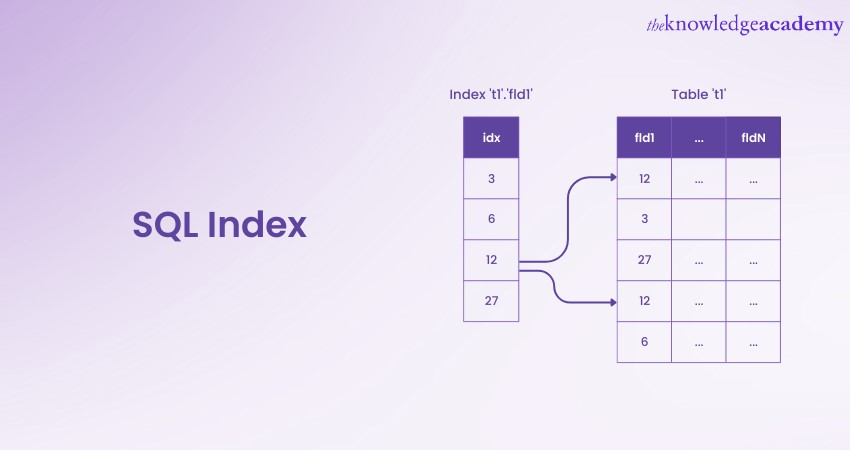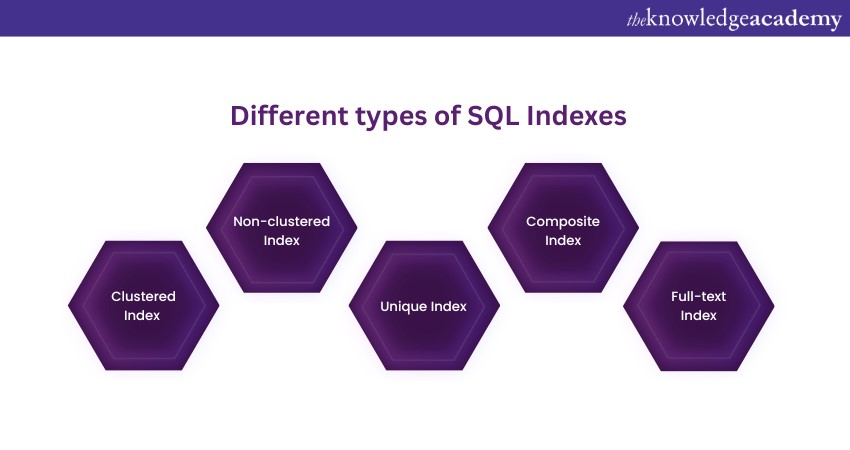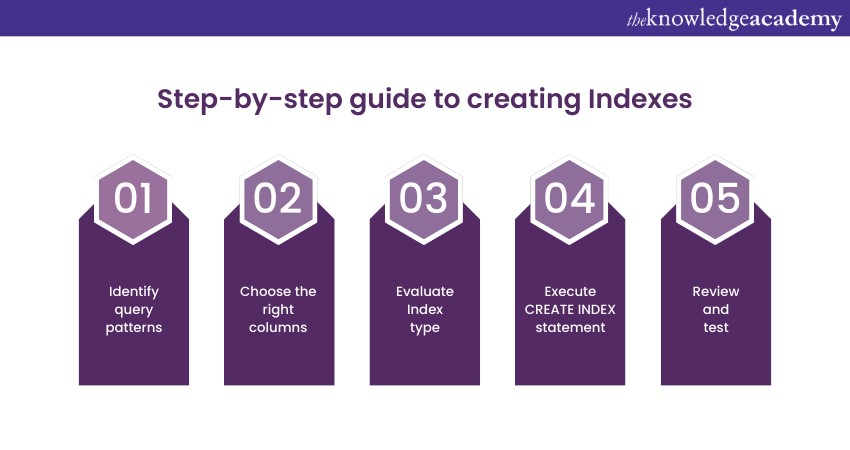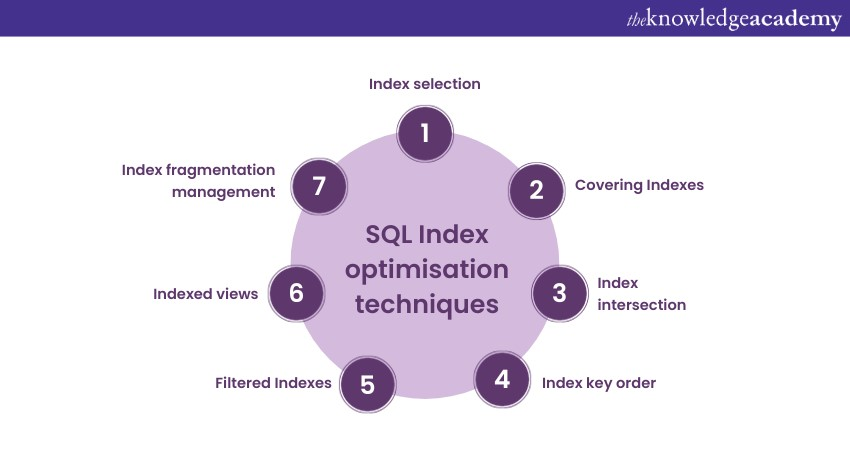We may not have the course you’re looking for. If you enquire or give us a call on + 1-866 272 8822 and speak to our training experts, we may still be able to help with your training requirements.
We ensure quality, budget-alignment, and timely delivery by our expert instructors.

Structured Query Language (SQL) Index plays a pivotal role in the world of database management, optimising query performance and streamlining data retrieval. As databases grow and become complex, efficient data access becomes increasingly critical. SQL Index is a structured method that empowers databases to swiftly access data, ensuring faster and more accurate query results.
If you wish to explore the significance of SQL Index, its various types, and how it operates to enhance overall database performance, this blog is what you need. Understanding the principles of Indexing will enable you to achieve greater efficiency in managing vast amounts of data. In this blog, you will learn about how to enhance query performance by using SQL Indexes in databases. Additionally, you will learn about the different types of Indexing techniques.
Table of Contents
1) Understanding database Indexing
2) Different types of SQL Indexes
3) How SQL Index works?
4) Creating and managing SQL Indexes
5) Conclusion
Understanding database Indexing
In the world of Database Management, the way data is stored and accessed is of paramount importance. Databases store information in structured tables, but as data grows, retrieving specific data becomes challenging. This is where the need for efficient data retrieval arises, and Database Indexing comes to the rescue as a powerful solution.
Databases use a tabular format to organise and store data. Each table consists of rows and columns, where each row is a record, and each column represents a specific field. This structured approach facilitates Data Management, but as the volume of data increases, scanning through every row becomes time-consuming and inefficient.
Database Indexing provides an optimised approach to enhance data retrieval speed. An Index is a separate data structure that complements the original table by storing a sorted list of specific columns' values. This allows the database engine to quickly locate the desired data, reducing the need for exhaustive scans and significantly improving query performance.
Unlock the power of data with our comprehensive Introduction to SQL Training – sign up now!
Different types of SQL Indexes
In the realm of SQL Database Management, various types of Indexes exist to cater to specific data organisation and retrieval needs. Understanding the differences between these Indexes is essential for optimising database performance. Let's explore the most common types of SQL Indexes:

Clustered Index
A clustered Index is used to determine the physical order of data rows in a table. In this Index, each table can have only one clustered Index, and its key dictates the way data is stored on disk. When a table has a clustered Index, the rows are physically sorted based on the Indexed column's values. This results in faster data retrieval for queries that use the clustered Index key, as related data is stored contiguously.
Non-clustered Index
Unlike a clustered Index, a non-clustered Index does not affect the physical order of data rows. Instead, it creates a separate data structure that holds the Indexed column's values along with pointers to the actual data rows. This enables the database engine to locate data quickly without reordering the rows physically. A table can have multiple non-clustered Indexes, each catering to different query patterns.
Unique Index
A unique Index ensures that the Indexed column contains only unique values. This means that no two rows in the table can have the same value in the Indexed column. A unique Index can be either clustered or non-clustered, and it helps enforce data integrity and prevent duplicate entries.
Composite Index
A composite Index combines multiple columns into a single Index. Instead of Indexing each column individually, a composite Index allows the database to Index a combination of columns. This is useful when queries involve multiple columns frequently, as the composite Index improves query performance by reducing the number of Indexes required.
Full-text Index
A full-text Index is specialised for efficiently searching large amounts of textual data. Unlike traditional Indexes that work on exact matches, full-text Indexes enable users to perform keyword-based searches within the text fields. This type of Index is especially beneficial for applications like search engines or text-heavy content repositories.
Unlock the power of data with our Introduction to MySQL Course – join now and become an SQL expert!
How SQL Index works?
SQL Indexing employs a well-organised structure to accelerate data retrieval and optimise query execution. By understanding its mechanics, we can harness its power to enhance database performance. The workings of SQL Indexing, including its structure, organisation, and underlying algorithms are as follows:
Index structure and organisation
An SQL Index is like a carefully crafted map that allows the database engine to swiftly locate specific data entries without scanning the entire table. The Index is stored separately from the actual table data and consists of two essential components: the Indexed column(s) and their corresponding pointers to the actual data rows.
When an Index is created on a column, the database engine sorts the values in that column in a particular order. This sorting is crucial because it enables efficient searching through a technique known as "Binary Search." The binary search method repeatedly divides the search space in half, dramatically reducing the number of comparisons needed to locate a specific value.
Underlying Indexing algorithms
Different Database Management systems employ various algorithms to create and maintain Indexes efficiently. Commonly used algorithms include B-Tree and Hash Indexing.
B-Tree Indexing: The Balanced Tree (B-Tree) algorithm is widely used in SQL databases. It organises Index data in a balanced tree-like structure, ensuring that all leaf nodes are at the same level. This balancing facilitates faster search and insertion operations. B-Tree Indexing excels in range queries as it can efficiently find data falling within a specific range.
Hash Indexing: Hash Indexing uses a hash function to map Index key values to specific locations within the Index. While it allows for rapid lookups, it is most effective for exact match queries. However, hash Indexes may not perform well for range queries or wildcard searches.
Advantages of SQL Indexing
SQL Indexing offers several advantages that significantly enhance database performance. By using Indexes, databases can:
1) Accelerate data retrieval: Indexes drastically reduce the number of rows the database engine needs to scan, resulting in faster data retrieval for queries.
2) Improve query performance: Queries that involve Indexed columns can be executed with greater efficiency, minimising query execution time.
3) Enhance sorting operations: Indexes streamline sorting operations for queries that involve order by clauses.
Limitations of SQL Indexing
While SQL Indexing brings tremendous benefits, it is essential to be aware of its limitations. Some considerations include:
1) Increased storage overhead: Indexes require additional storage space, which may impact overall database size.
2) Index maintenance overhead: As data is added, modified, or deleted, Indexes must be maintained, leading to increased overhead during data manipulation.
3) Not always suitable for all queries: Indexes are most effective for queries that involve Indexed columns. Queries involving non-Indexed columns may not benefit from Indexing.
Take Control of Your Data: Uncover the Advantages of SQL and Drive Business Intelligence with Ease!
Creating and managing SQL Indexes
Implementing SQL indexes is a crucial aspect of optimising database performance. It involves a systematic approach to creating and maintaining indexes effectively. Here is the emphasis on best practices for Index maintenance, which highlights the significance of monitoring index performance:
A step-by-step guide to creating Indexes
A step-by-step guide to creating Indexes is essential as it helps Database Administrators systematically identify columns for Indexing, choose the appropriate Index type, and implement Indexes efficiently. This approach ensures optimised query performance, accelerates data retrieval, and improves the overall efficiency of the database system.

1) Identify query patterns: Begin by analysing the frequently executed queries in your database. Identify the columns involved in these queries, as those are the prime candidates for Indexing.
2) Choose the right columns: Select the columns with high selectivity, meaning they contain a wide range of unique values. Indexing on such columns enables the database engine to narrow down the search space efficiently.
3) Evaluate Index type: Decide on the type of Index that best suits your database and query needs. Consider whether a clustered or non-clustered Index is appropriate for the chosen column(s).
4) Execute CREATE INDEX statement: Once you've chosen the columns and Index type, execute the appropriate SQL statement to create the Index. For example, in SQL Server, the CREATE INDEX statement is used.
5) Review and test: After creating the Index, review its impact on query performance. Use query execution plans and performance monitoring tools to ensure that the Index is being utilised effectively.
Best practices for Index maintenance
Best practices for Index maintenance are crucial for ensuring a well-maintained database. Regularly updating statistics, avoiding over-Indexing, and addressing Index fragmentation leads to optimal Index performance. By following these practices, databases can sustain efficient query execution, minimise storage overhead, and maintain peak database performance over time.
1) Regularly update statistics: Keep Index statistics up to date to enable the database optimiser to make informed decisions about query plans.
2) Avoid over-Indexing: Creating too many Indexes can lead to increased storage overhead and maintenance costs. Evaluate the necessity of each Index and avoid redundant Indexes.
3) Periodically rebuild and reorganise Indexes: Over time, Indexes can become fragmented, leading to decreased performance. Regularly rebuild or reorganise Indexes to maintain efficiency.
4) Monitor Index fragmentation: Use built-in database tools to monitor Index fragmentation regularly. Address fragmentation by rebuilding or reorganising Indexes when required.
Monitoring Index performance
Monitoring Index performance is vital for maintaining an efficient database system. By analysing query execution times, tracking Index usage statistics, and using monitoring tools, administrators can identify bottlenecks and optimise Indexes as needed. This ensures optimal query response times and enhances overall database performance.
1) Query performance analysis: Monitor query execution times for queries that involve Indexed columns. Identify any slowdowns and determine if the existing Index is effective or requires optimisation.
2) Index usage statistics: Most database systems provide tools to track Index usage. Evaluate which Indexes are heavily used and which ones are seldom utilised. Consider optimising or removing underused Indexes.
3) Database monitoring tools: Leverage monitoring tools to keep track of Index-related metrics such as Index scans, seeks, and updates. This information aids in identifying performance bottlenecks.
SQL Index optimisation techniques
Optimising SQL Indexes is crucial for achieving optimal query performance. By understanding query optimisation and utilising Index hints and tips, Database Administrators can fine-tune their databases to deliver faster and more efficient query processing.
Query optimisation is the process of selecting the most efficient query execution plan from various available alternatives. The database optimiser analyses query syntax and data distribution to determine the best way to retrieve data. An optimised query plan minimises resource usage and execution time, resulting in improved performance.

1) Index selection: Choose the right columns to Index based on query patterns and data distribution. Optimise Indexes for commonly executed queries to ensure quick data retrieval.
2) Covering Indexes: Create covering Indexes that include all columns required for a query. This allows the database engine to retrieve data directly from the Index without the need for additional table lookups, improving performance.
3) Index intersection: Combine multiple Indexes to create an intersection of Indexes that cater to specific query needs. This technique can optimise complex queries involving multiple conditions.
4) Index key order: Arrange the columns in an Index's key in the order that matches the frequently used query conditions. This allows for efficient searching within the Index.
5) Filtered Indexes: Use filtered Indexes for selective Indexing, where the Index covers only a subset of rows based on specific criteria. This reduces Index size and maintenance overhead.
6) Indexed views: Create Indexed views to store the results of frequently executed complex queries. This approach precomputes the query results, speeding up subsequent queries.
7) Index fragmentation management: Regularly monitor and address Index fragmentation through reorganisation or rebuilding to maintain optimal performance.
Conclusion
SQL Indexes play a pivotal role in optimising database performance and query execution. By implementing well-designed Indexes and adhering to best practices for Index maintenance, databases can achieve faster data retrieval and improved system efficiency. SQL Indexes are indispensable tools for enhancing overall Database Management and ensuring optimal query response times.
Frequently Asked Questions
What are the Other Resources and Offers Provided by The Knowledge Academy?

The Knowledge Academy takes global learning to new heights, offering over 3,000 online courses across 490+ locations in 190+ countries. This expansive reach ensures accessibility and convenience for learners worldwide.
Alongside our diverse Online Course Catalogue, encompassing 19 major categories, we go the extra mile by providing a plethora of free educational Online Resources like News updates, Blogs, videos, webinars, and interview questions. Tailoring learning experiences further, professionals can maximise value with customisable Course Bundles of TKA.
Upcoming Programming & DevOps Resources Batches & Dates
Date
 Introduction to SQL Databases Training 10985C
Introduction to SQL Databases Training 10985C
Mon 19th May 2025
Mon 21st Jul 2025
Mon 15th Sep 2025
Mon 17th Nov 2025
Mon 15th Dec 2025






 Top Rated Course
Top Rated Course



 If you wish to make any changes to your course, please
If you wish to make any changes to your course, please


